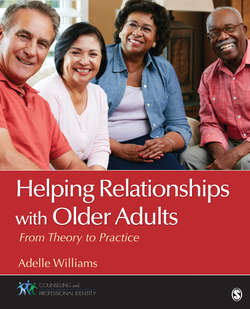Читать книгу Helping Relationships With Older Adults - Adelle M. Williams - Страница 61
На сайте Литреса книга снята с продажи.
Rethinking the Value of Aging
ОглавлениеWhile it might be difficult to change culture and the way elders are viewed in society, there are practical steps that communities, employers, and individuals can begin to take to prepare for a society with greater numbers of healthy elders. First, it is worth reassessing the responsibilities and assets of elders. All ages need roles in life. According to Erik Erikson (1959), the hallmark of successful late-life development is the capacity to be generative and to pass on to future generations what one has learned from life. The elderly can be viewed as “America’s one growing resource,” and aging can be viewed as an opportunity to be seized (Freedman, 2002). More than half of all older adults volunteer their time, and more opportunities are available to contribute to their communities.
Firms are integrating workforces through programs of “unretirement” or by rehiring retirees as temps, consultants, and part-time workers. Surveys suggest that the 60-year trend of a decreasing number of elderly working has reversed itself as baby boomers reconsider their financial needs for retirement as well as how they want to spend more than a third of their adult life (Walsh, 2001). Most forecasters project this trend to continue as more elderly work longer for economic, social, and personal reasons; employers become more flexible and aware of the needs and benefits of older workers; and the labor market remains tight, with a smaller number of available younger workers.
The sheer size and energy of the baby boom generation has led to other dramatic social shifts, and experts hope that a new imagery for aging is possible. A growing interest in “age integration”—a process that takes advantage of the broadened range of accumulated life course experiences in society—has occurred over the last few decades. In an age-integrated society, changes made to bring older people into the mainstream could simultaneously enlarge personal opportunities and relieve many other people who are in their middle years of the work–family “crunch” (Uhlenberg, 2000). Actual physical integration can also take place. Although some towns have seen a trend toward senior-only housing, others are exploring options in integrated apartment buildings. Some older persons prefer a mixed-age neighborhood over one restricted to people their own age. Some community centers are integrating senior centers with childcare centers, facilitating cross-age interaction and conserving space and resources (Knickman & Snell, 2002). Cultural change is also possible with regards to one-on-one relationships. Baby boomers have made an art of enjoying and taking pride in caring for their children, even managing to pay for college tuition. The needed cultural shift is for children and communities to find more enjoyment and pride in providing for the care of parents and neighbors. The ultimate intangible goal is to recognize the reciprocity within all aspects of society. Everyone can benefit when the elderly are fully integrated into a caring society (Knickman & Snell, 2002).
It is clear that the process of aging, societal influences, organizational dynamics, and lack of adequately trained practitioners will influence the therapeutic work needed by older clients. Helping professionals and those in training have enormous opportunities to not only provide services to older adults, but to act as change agents within the larger society. Helping professionals will need to strongly advocate on behalf of their elderly clients and advocate against the institutional policies that impede full participation.
Many baby boomers express a desire and a need to continue with employment, though only a small number of employers are genuinely interested in utilizing their services. Helping professionals who understand and can promote the strengths, abilities, and competencies of the older worker to employers will prove extremely valuable in this process. Educating different constituents in society will dispel myths and erroneous information regarding the aging process and potentially open doors to various opportunities for older persons. Helping practitioners are in a good position to assist elderly clients with navigating personal, societal, and organizational barriers that might interfere with their well-being.
The real challenges of caring for the elderly in 2030 will involve (1) making sure society develops payment and insurance systems for long-term care that work better than existing ones, (2) taking advantage of advances in medicine and behavioral health to keep the elderly as healthy and active as possible, (3) changing the way society organizes community services so that care is more accessible, and (4) altering the cultural view of aging to make sure all ages are integrated into the fabric of community life (Knickman & Snell, 2002). If these challenges can be addressed, the quality of life of all individuals can be vastly improved.
